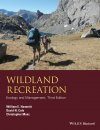About this book
This third edition provides an updated and thorough examination of the ecological impacts of recreational use on wildlands and the best management practices to employ in places where recreation and preservation of natural conditions are both important – and often conflicting – objectives.
Covering the latest research, this edition provides detailed information about the environmental changes that result from recreational use. It describes spatial patterns of impact and trends over time, then explores the factors that determine magnitude of impact, including amount of use, type and behavior of use, and environmental durability. Numerous examples, drawn from parks and recreation areas around the world, give readers insight into why certain areas are more heavily damaged than others, and demonstrate the techniques available to mitigate damage.
Wildland Recreation incorporates both the first-hand experience of the authors and an exhaustive review of the world's literature on the subject. Boxes provide quick access to important material, and further resources are referenced in an extensive bibliography. Essential reading for all park and protected area management professionals, Wildland Recreation is also a useful textbook for upper division undergraduate and graduate students on recreation ecology and recreation management courses.
Contents
Concise table of contents:
Preface viii
About the companion website x
PART I Introduction 1
1 Wildland Recreation and Resource Impacts 3
PART II IMPACTS TO RESOURCE COMPONENTS 19
2 Soil 21
3 Vegetation 41
4 Wildlife 56
PART III Impact patterns and trends 97
5 Water 80
6 Impact Patterns 99
PART IV FACTORS AFFECTING IMPACTS 133
7 Trends in Wildland Recreation 113
8 Environmental Durability 135
PART V MANAGEMENT ALTERNATIVES 179
9 Visitor Use and Behavior 152
10 Strategies and Concepts of Management 181
11 Monitoring Recreational Impacts 196
12 Visitor Management 219
13 Site Management 248
PART VI Conclusion 297
14 Air Sound and Technology: New Issues for Recreation Ecology 277
15 A Lasting Impact 299
References 305
Index 306
Detailed table of contents:
Preface viii
About the companion website x
PART I Introduction 1
1 Wildland Recreation and Resource Impacts 3
1.1 What is Wildland Recreation? 3
1.2 What is Recreation Resource Impact? 6
1.3 Ecological Impacts of Wildland Recreation 6
1.4 Recreation Ecology 9
1.5 The Importance of Ecological Impacts 10
1.6 The Manager’s Role 12
1.7 Recreational Capacities 12
1.8 Themes of this Book 14
References 16
PART II IMPACTS TO RESOURCE COMPONENTS 19
2 Soil 21
2.1 Basic Soil Ecology 21
2.1.1 What is soil? 21
2.1.2 Soil texture and structure 21
2.1.3 Pore space 22
2.1.4 Bulk density 23
2.1.5 The soil profile 23
2.2 Effects of Recreation on Soils 24
2.2.1 Organic matter 25
2.2.2 Profile truncation 27
2.2.3 Soil compaction 28
2.2.4 Macroporosity and infiltration rate 29
2.2.5 Soil moisture 31
2.3 Soil Erosion 32
2.3.1 Erosion as a natural process 32
2.3.2 Recreation and erosion 33
2.3.3 Other soil impacts 35
2.3.4 Impacts associated with campfires 36
2.4 Summary 37
References 38
3 Vegetation 41
3.1 Vegetation Impact Parameters 41
3.1.1 Amount of vegetation 41
3.1.2 Species composition and other properties 43
3.1.3 Tree condition 43
3.2 Understanding Vegetation Impacts 43
3.2.1 Ground cover 44
3.2.2 Shrubs and saplings 51
3.2.3 Mature trees 51
3.3 Summary 53
References 53
4 Wildlife 56
4.1 Recreation Influences on Wildlife Responses 56
4.2 Wildlife Responses to Recreation 57
4.3 Human–Wildlife Interactions 58
4.4 Recreation–Wildlife Impacts 59
4.4.1 Animal disturbance and harassment 60
4.4.2 Harvest 62
4.4.3 Habitat modification 63
4.4.4 Alteration of behavior 64
4.4.5 Species displacement and reproduction level 66
4.4.6 Species composition and structure 67
4.5 Impacts on Wildlife Species 67
4.5.1 Large mammals 67
4.5.2 Medium-sized animals 73
4.5.3 Small animals 74
4.5.4 Fish 75
4.6 Summary 75
References 76
5 Water 80
5.1 Dispersed Recreation and Water Impacts 80
5.2 Basic Water Ecology 81
5.2.1 Water temperature and flow 82
5.2.2 Dissolved oxygen 83
5.2.3 Nutrient influx 83
5.2.4 Coliform bacteria and other pathogens 85
5.3 Backcountry Camping and Drinking Sources 88
5.4 Solid Waste and Foreign Materials 89
5.5 Suspended Matter and Turbidity 90
5.6 Summary 93
References 93
PART III Impact patterns and trends 97
6 Impact Patterns 99
6.1 Spatial Patterns of Impact 99
6.1.1 Impact zone 100
6.1.2 Intersite zone 101
6.1.3 Buffer zone 101
6.2 Impact Patterns at Multiple Spatial Scales 103
6.3 Temporal Patterns of Impacts 104
6.4 Recovery Rates of Resources 108
6.5 Summary 110
References 111
7 Trends in Wildland Recreation 113
7.1 Use and Impacts 113
7.2 Early Recent and Projected Outdoor Recreation Use 113
7.3 Trends in Wildland and Wilderness Use 117
7.4 Trends in Wildland and Wilderness Users 120
7.4.1 Conclusions drawn from trend synthesis 122
7.5 Trends in Wildland Impacts 124
7.5.1 Trail impact trends 124
7.5.2 Campsite impact trends 125
7.6 Summary 129
References 129
PART IV FACTORS AFFECTING IMPACTS 133
8 Environmental Durability 135
8.1 Vegetation 136
8.2 Soil Characteristics 141
8.3 Topographic Characteristics 143
8.4 Ecosystem Characteristics 144
8.4.1 Wildlife 145
8.5 Aquatic Environments 146
8.6 Season of Use 146
8.7 Map-Based Analysis Approaches 147
8.8 Summary 147
References 149
9 Visitor Use and Behavior 152
9.1 Amount of Use 153
9.2 Use Distribution 156
9.2.1 Type of use 157
9.3 Party size 157
9.4 User behavior 160
9.4.1 Minimum impact knowledge 160
9.4.2 Experience level 163
9.4.3 User motivation 164
9.4.4 Social group and structure 164
9.5 Place Bonding 165
9.6 Mode of Travel 167
9.6.1 Snowmobiles skis and snowboards 167
9.6.2 Motorboats personal watercraft and nonmotorized boats 168
9.6.3 Off-road vehicles mountain bikes stock and foot travel 169
9.7 Summary 173
References 174
PART V MANAGEMENT ALTERNATIVES 179
10 Strategies and Concepts of Management 181
10.1 General Principles 181
10.2 Planning for Management 183
10.2.1 Recreation opportunity spectrum 183
10.2.2 A visitor use management framework 184
10.3 Management of Problems 189
10.3.1 Strategic purpose 189
10.3.2 Types of undesirable visitor actions 191
10.3.3 Types of management approaches 191
References 194
11 Monitoring Recreational Impacts 196
11.1 Camp and Picnic Sites 196
11.1.1 Photographs 198
11.1.2 Condition class estimates 199
11.1.3 Multiple parameter systems 200
11.2 Trails and Roads 208
11.2.1 Samples at fixed locations 208
11.2.2 Rapid survey samples 210
11.2.3 Census techniques 211
11.2.4 Informal trails 212
11.2.5 Roads and off-road vehicle trails 214
11.3 Water Bodies 215
11.4 Wildlife 216
11.5 Developing a Monitoring System 216
References 217
12 Visitor Management 219
12.1 Use Limits 220
12.2 Length of Stay Limits 224
12.3 Dispersal of Use 225
12.4 Concentration of Use 231
12.5 Restrictions on Type of Use 232
12.6 Group Size Limits 234
12.7 Low Impact Education 236
12.7.1 Message content 236
12.7.2 Effective communication 238
12.8 Seasonal Limitations on Use 241
12.9 Campfire Management Alternatives 242
12.10 Visitor Information Needed to Manage Recreation Impacts 244
References 245
13 Site Management 248
13.1 Locating Use on Resistant Sites 249
13.2 Permanent Closures 253
13.3 Temporary Site Closures 254
13.4 Influencing Spatial Distribution of Use 256
13.5 Site Hardening and Shielding 260
13.6 Rehabilitation of Closed Sites 270
References 275
14 Air Sound and Technology: New Issues for Recreation Ecology 277
14.1 Air Quality 277
14.1.1 Within-park emissions 278
14.1.2 Importance of air pollution 280
14.1.3 Night sky light visibility 283
14.1.4 Summary and solutions 284
14.2 Natural Soundscapes 284
14.2.1 Understanding soundscapes and key ecological concerns 286
14.2.2 Impacts of noise on visitor experiences in wildlands 288
14.2.3 Assessment and monitoring of soundscapes 290
14.2.4 Summary and solutions 291
14.3 Technology 291
14.3.1 Improved technology 291
14.3.2 New recreational activities 292
14.3.3 Electronic technology 293
14.3.4 Summary and solutions 295
References 295
PART VI Conclusion 297
15 A Lasting Impact 299
15.1 Wildland Recreation and Resource Impacts: Necessities 299
15.2 Understanding the Resource 300
15.3 Environment and Visitor Influences 300
15.4 Some Management Tools 301
15.5 New Issues and Knowledge 302
15.6 Lasting into the Future 303
References 305
Index 306
Customer Reviews
Biography
William Hammitt is Professor Emeritus in the Departments of Parks, Recreation and Tourism Management, and Forest Resources, at Clemson University, South Carolina. His research specialties include the environmental psychology of privacy-solitude, place bonding, visual preferences within wildland settings, and user impacts in wildland recreation areas.
David Cole is Emeritus Scientist at Aldo Leopold Wilderness Research Institute, Missoula, Montana. He has conducted research in recreation ecology for 40 years, particularly in wilderness areas in the United States.
Christopher Monz is Associate Professor of Recreation Resource Management in the Department of Environment and Society at Utah State University, Utah. He teaches courses in outdoor recreation management, ecological impacts of recreation, nature-based tourism, interpretation and outdoor education. His research specialty is recreation ecology where he has worked extensively on recreation disturbance to soil and plant communities.




































